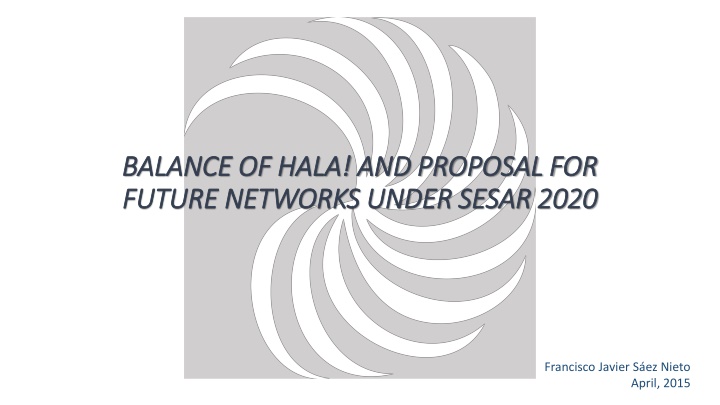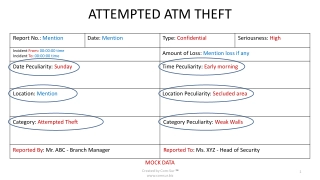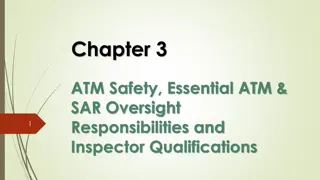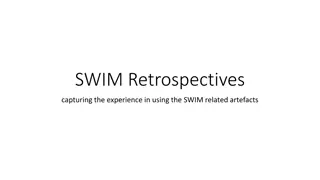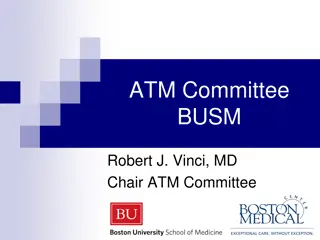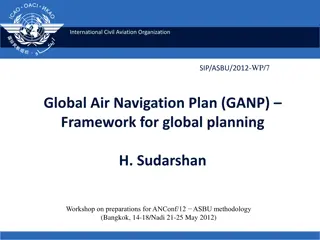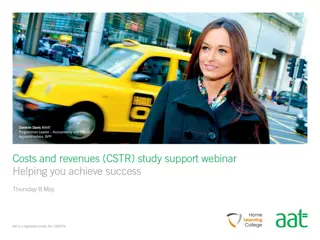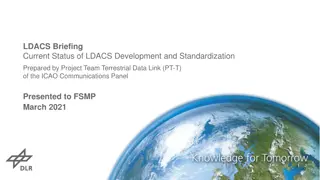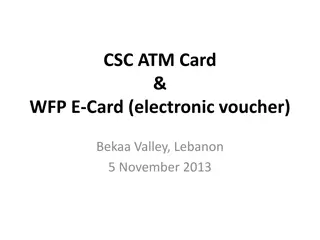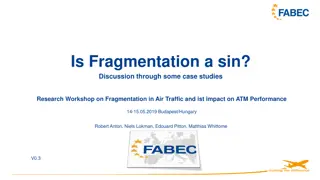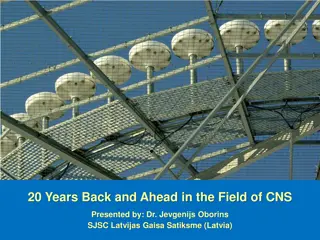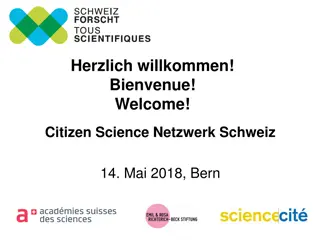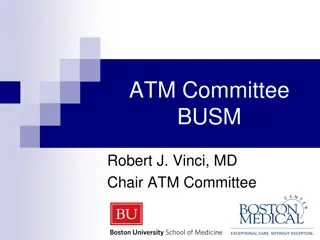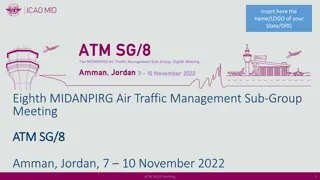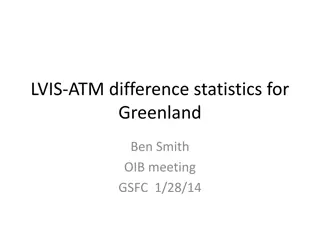Contribution of HALA Network to ATM Community and SESAR 2020: Achievements and Future Directions
HALA network has been instrumental in fostering research and innovation in the field of automation for ATM systems, providing a platform for knowledge dissemination, collaboration, and advancement. The network has facilitated exploratory research, encouraged young scientists' participation, and created a repository of ongoing research activities. Participation in the network has allowed members to stay updated with the latest developments in ATM and related scientific disciplines, positioning them at the forefront of research in the industry. The network's general balance in participating has connected key players in the field and provided a unique platform for expressing innovative ideas about the future operational architecture of ATM systems.
Download Presentation

Please find below an Image/Link to download the presentation.
The content on the website is provided AS IS for your information and personal use only. It may not be sold, licensed, or shared on other websites without obtaining consent from the author.If you encounter any issues during the download, it is possible that the publisher has removed the file from their server.
You are allowed to download the files provided on this website for personal or commercial use, subject to the condition that they are used lawfully. All files are the property of their respective owners.
The content on the website is provided AS IS for your information and personal use only. It may not be sold, licensed, or shared on other websites without obtaining consent from the author.
E N D
Presentation Transcript
BALANCE OF HALA! AND PROPOSAL FOR BALANCE OF HALA! AND PROPOSAL FOR FUTURE NETWORKS UNDER SESAR 2020 FUTURE NETWORKS UNDER SESAR 2020 Francisco Javier S ez Nieto April, 2015
CONTENT: Contribution of HALA! network to the ATM Community and SESAR, General and overall balance of participating in networks for ATM, Lessons learnt and what to improve, Best practices, How to face and organise networks under SESAR 2020.
Contribution of HALA! network to the ATM Community and SESAR: Provide the framework to carry out research in Automation with a major focus on ATM; Provide a highly specialized and fruitful venue for dissemination and discussion of advances performed by R&D organizations in the field of automation; Stimulate exploratory research, creativity and innovation in ATM system (SESAR and beyond) grounding the results in knowledge from other domains involving automation; Organize work activities for providing solutions (exploiting knowledge and results from the scientific research community) to the objectives of SESAR in areas such as aircraft trajectory management and cohesion, human factors, improved performances within the ATM or safety among others; Encouraged participation of young scientists and young researchers in the field of R&D applied to ATM to provide new approaches. Create and support a lively scientific community around the particular area of automation which was previously scattered in various disciplines; Providing a repository of undergoing research in these domains fostering research activities in underrepresented areas and preventing duplication of efforts in popular ones.
General and overall balance of participating in networks for ATM, Has been an instrument to meet key players in the field and to stay in the leading edge of research in the area of the network. Networking activities and to learn from theoretical contributions, advances and findings regarding the future ATM system Participation allows members to stay in the loop and stay tuned with the state of the art in their areas or interest and in related scientific disciplines.
General and overall balance of participating in networks for ATM (Cont.), Position Paper. Provide a unique open platform to express the views and reveal the knowledge existing within the research community This is achieved by the elaboration and development of the so call Position Paper through which their members provide new and innovative ideas about the future ATM operational architecture and about the role that automation should play. HALA! SESAR Research Network Towards Higher Levels of Automation in ATM Position Paper
Lessons learnt and what to improve, Internal organization and participants: The management work has exceeded initial expectations, implying effort than expected at the expense of research and dissemination activities. The coordination of a large number of members, the limited resources and the required administrative paperwork have been the cause for management burden. Both, the administrative mechanisms and the number of the core members should be reduced. Maximize the number of participants, knowledge or academic initiatives is essential Members/participants should really be engaged in the network activities. External organization: Dissemination are key in networks activities to ensure the impact of the research work produced. This concerns both the research communities and the ATM Community. Promotion of joint activities with other disciplines (social sciences, computer sciences, etc..) and other industries (ground transportation, games and entertainment, nuclear, space, ). Some targeted support from SJU and/or EUROCONTROL could be helpful advertising the networks activities.
Best practices (1) Activities performed under the networks (e.g HALA! Research Network) have proved to provide a highly revenue to the members and have been an excellent framework to disseminate knowledge and findings in the field. ATACCS Conference: has provided a highly specialized forum to discuss the findings and advances achieved in automation within ATM. Having the proceedings of the conference available in the ACM digital library (http://dl.acm.org/citation.cfm?id=2494493) guarantees worldwide access to the research communities. ATACCS'2015 ATACCS'2015 5thInternational Conference on Application and Theory of Automation in Command and Control Systems
Best practices (2) HALA! SUMMER SCHOOL: AIR TRAFFIC SYSTEMS BASED ON 4D TRAJECTORY MANAGEMENT
Best practices (3): Funded PHD Thesis Exploiting Innovation Sensor Data Fusion Strategies for Sense and Avoid Units to be installed onboard Unmanned Aerial Systems A multi-model S based approach for the analysis and modelling of usable and resilient partly autonomous interactive systems Trajectory management, including trajectory optimization, demand/capacity balancing, traffic synchronization safety barriers, detect and avoid systems, autonomy of flight/vs, centralised services provision, latency effects on all kind of agents remotely controlled are, among others, key research issues, that involves especially RPAS. Application of the Theory of FL to the Modelling of Trajectory Uncertainty and the Analysis of its Impact in Future Trajectory- Based Operations AUTOFLY Aid: Flight Deck Automation Support with Dynamic 4D Trajectory Management for Responsive and Adaptive Airborne Collision Avoidance Uncertainty reduction by an ATS inherent aircraft state vector modelling and estimation Stochastic Optimal Control towards Enhanced Predictability of four- dimensional Trajectories using of Weather Ensemble Prediction Forecasts Supporting function allocation in human automation by means of dynamic performance measurement Context-Aware Adaptive Automation in ATC Aircraft Turnaround Management in a highly automated 4D flight operations environment Aircraft Trajectory hierarchal, spatial and temporal cohesion among the different ATM agents, considered as part of a socio- technical multi-agent system, as key element for an efficient integrated ATM Information Automation on the Flight Deck in the Context of 4D Trajectory based Operations Development of an autonomous knowledge-based system state evaluation for an enhanced decision making process Robust data fusion for 4D conflict-free optimal trajectories in a highly automated ATM system User interface design for highly automated systems
Best practices (4): Position Paper New role assignment based on : ATM Automation First dimension BEST TIME for decision making: Strategic vs. tactical planning layer Second dimension DECISION PLACE : Controlled vs. autonomy. Third dimension BEST PLAYER : Human vs. automated player. Improvement of Processes through the use of Technology Flight Trajectories Management ATM Invariants Goals Limitations Efficiency (broad sense: user, provider & society ) Safety (Separation Assurance) Airport Capacity Atmospheric Behaviour
How to face and organise networks under SESAR 2020 Role Benefits Knowledge of and participation to the definition of the future ATM research strategy and agenda Networking opportunities Collaboration with qualified top level potential partners Contribution and participation to dedicated Workshops Contribution and participation to qualified Conferences Training opportunities for young researchers (such as summer schools) PhD for young researchers Economic revenues resulting from some of the activities above (indirect) Direct economic compensation for the work Core member Networking opportunities Contribution and participation to dedicated Workshops Contribution and participation to qualified Conferences Reading material about the research state of the art, open issues, etc. Training opportunities for young researchers (such as summer schools) PhD for young researchers Participation in publications related to specific topics from the network Participant Contribution and participation to qualified Conferences Reading material about the research state of the art, open issues, etc. Training opportunities for young researchers (such as summer schools) User
